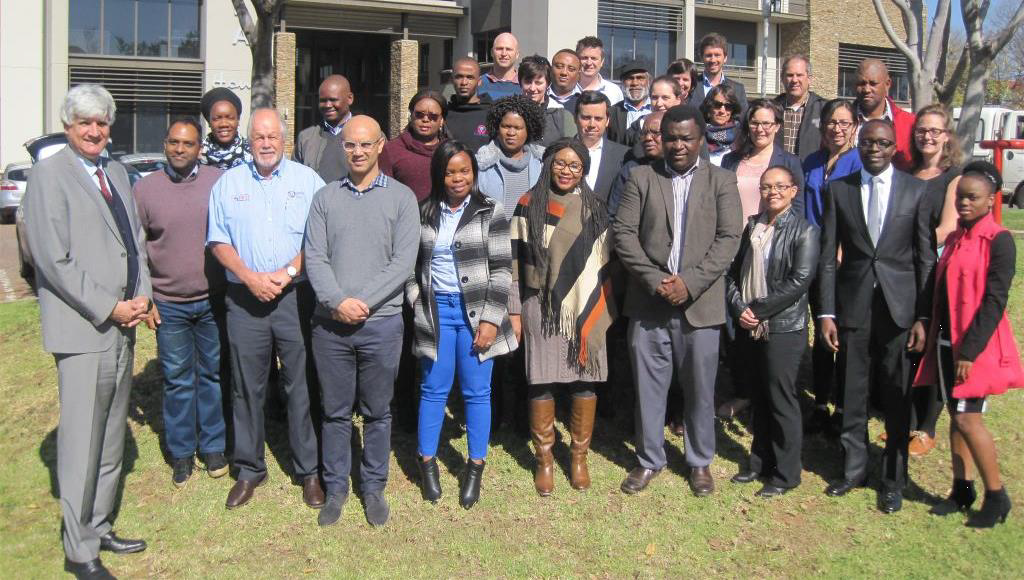
Group photo taken during the drought risk workshop at the National Disaster Management Centre (NDMC) in Pretoria.
Droughts have wide-ranging impacts on health, water supply and economic sectors, especially agriculture, globally. Understanding, assessing and monitoring drivers, patterns and hotspots of drought risk is an important prerequisite for reducing drought risk and potential adverse effects.
Since El Nino, a warm phase of the Southern Oscillation in the Pacific leading to warm sea surface temperatures with impact on the seasonal climate, had induced a drought in 2015, South Africa is facing an exceptional water crisis. This has led to drastic water restrictions in Cape Town, such as water being limited to 50 liters per capita per day, but also to high unemployment rates and economic losses in the agricultural sector.
Since South Africa is one of the five partner countries in the GlobeDrought project, researchers from United Nations University (UNU-EHS) in Bonn have recently conducted a one-week scoping mission to South Africa from 04-09 June 2018. The mission was used to meet relevant stakeholders at national and provincial levels, participate in workshops on the state of drought risk assessment in the country, and identify relevant policies, potential gaps and user needs in order to evaluate entry points for future collaboration.
During the mission, researchers from UNU-EHS participated in two full-day workshops on drought risk assessment organized by UN-SPIDER and the University of the Free State (UFS) within the context of their EvIDENZ project at the National Disaster Management Centre (NDMC) in Pretoria and in the Eastern Cape, had a series of bilateral meetings with relevant stakeholders at the national (i.e. NDMC; Department of Water & Sanitation; South African Weather Service; South African Space Agency) and sub-national (i.e. Provincial Disaster Management Centre of Western Cape) level, and participated in a one-day field trip in the Eastern Cape. The workshop at the NDMC in Pretoria was aimed especially at decision-makers and government agencies at the national level, while the workshop in the Eastern Cape was aimed at local stakeholders and local government actors – allowing for both the national and a sub-national perspective.
The workshops and stakeholder consultations showed that South Africa has institutions and the capacity to generate data and studies to assess drought risk (e.g. an extensive set of weather stations, vegetation conditions monitor, agricultural, dam, vegetation and socioeconomic data). However, there is a gap between the institutions to share and access this information. A lot of data and information, notably on drought hazards, is available, but it remains scattered. Integrated, holistic assessments of the risks of adverse impacts of droughts on different sectors (e.g. agricultural systems, water supply, etc.) are currently not yet available. This underscores the importance of avoiding silo thinking in order to strengthen knowledge and data transfer between institutions. Stakeholders showed their interest and articulated the need to add vulnerability aspects more systematically in their drought risk assessments in a structured and standardized manner, and highlighted the importance of understanding drought risk, its drivers and impacts.
Further, the mission has revealed that efforts are ongoing to establish drought risk information portals and systems in the country. According to the National Disaster Management Act of 2002, §17, and the Disaster Management Amendment Act of 2015, the NDMC should act as repository of and conduit for information concerning disasters and disaster management in the country, including information on drought risk. In order to fulfil that role, the NDMC has begun to develop Indicative Risk Profiles for different hazards and to establish a Risk Portal for sharing and disseminating risk information which provides an additional entry point for future collaboration with the GlobeDrought consortium.
The workshop and bilateral discussions clearly emphasized the need for collaboration on hazard model comparison and the development of more targeted vulnerability assessments for drought impacts at the national and provincial level. South Africa is very advanced regarding data information sources and drought hazard monitoring. And with the experience of the negative drought impacts in Cape Town such the severe water restrictions, the country is aware of the importance to assess drought risk considering the hazard, exposure and vulnerability in order to monitor disaster impacts and changes in risk as well as the relevance of proper adaptation measures.
